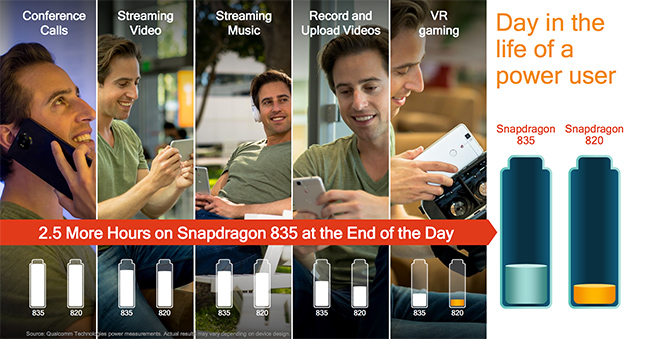The Qualcomm Snapdragon 835 Performance Preview
by Matt Humrick & Ryan Smith on March 22, 2017 4:30 AM EST- Posted in
- Smartphones
- Snapdragon
- Qualcomm
- Mobile
- SoCs
- Snapdragon 835
- Kryo
First Thoughts
Mobile SoCs are packed with specialized processors: CPU, GPU, high-performance DSP (compute), low-power DSP (sensor hub), modem DSP (signal processing), ISP (image processing), fixed-function blocks (video, audio), etc. And while all of these pieces contribute to the overall user experience, some of them are difficult to quantify. The CPU and GPU remain vital to device performance and battery life, so it’s still important to probe their capabilities.
Our initial testing shows that Snapdragon 835’s Kryo 280 CPU is an octa-core, big.LITTLE configuration with four semi-custom A73 “performance” cores and four semi-custom A53 “efficiency” cores. Kryo 280’s performance cores are pretty much equivalent to Kirin 960’s A73 cores in both integer and floating-point IPC, but comparing them to Snapdragon 820’s Kryo CPU shows mixed results: integer IPC improves but floating-point regresses.
In our limited system testing, the Snapdragon 835’s IPC gains outweigh its losses, providing better overall performance than the Snapdragon 820/821 phones. Unsurprisingly, the Snapdragon 835 MDP/S matched the performance of the Mate 9’s Kirin 960, which may not sound all that exciting, but considering our positive experience with the Mate 9, it’s certainly not bad either.
Qualcomm continues to push hard into VR/AR, not just with smartphones but stand-alone HMDs too. The high resolution and low latency requirements for these experiences suddenly make the GPU a bottleneck once again. The Snapdragon 835’s updated Adreno 540 GPU, through a combination of microarchitecture tweaks and a higher peak operating frequency, is another evolutionary step along the VR path, delivering a 25% peak performance boost over Snapdragon 820’s Adreno 530.
As noted earlier, all of these results came from pre-production hardware and software that’s under Qualcomm’s control, so performance could still go up or down once retail units begin shipping; however, based on these preliminary numbers and feature additions, the Snapdragon 835 looks like a solid evolutionary upgrade over the S820. The one glaring omission in this initial assessment, though, is power efficiency, which is critical to both battery life and sustained performance. The potential power savings from the move to 10nm and the CPU swap could have a larger impact on user experience than the small performance gains and new features.













128 Comments
View All Comments
deathBOB - Wednesday, March 22, 2017 - link
Apparently you didn't read the article.Meteor2 - Wednesday, March 22, 2017 - link
Really good article. I wish you'd do GB4/MHz testing for Apple's ARM cores and for x86 chips though! And dump Kraken for Octane. The latter is much broader, isn't it?Couldn't you use Chrome on iOS to level the playing field a bit for JavaScript benchmarks?
Meteor2 - Wednesday, March 22, 2017 - link
Actually ignore the Octane bit. I didn't realise JetStream included the Octane tests.Meteor2 - Thursday, March 23, 2017 - link
I was having a bad day. Chrome on iOS uses WebKit and Nitro, just like Safari. So JS benchmark results are the same.lilmoe - Wednesday, March 22, 2017 - link
"Qualcomm's Thoughts on Benchmarks versus End-User Experiences""And that means they need to promote and sell their SoCs as the sum of their parts, and not just a CPU with a bunch of extra stuff bolted on."
False. Only the CPU matters. Co-processors are a damn gimmick. GB and browser benchmarks FTW.
pSupaNova - Wednesday, March 22, 2017 - link
False, Qualcomm has been able to see of competitors with their integrated modems, heterogeneous computing matters more in the mobile arena not geeky benchmarks.fanofanand - Wednesday, March 22, 2017 - link
Their modems are the reason manufacturers are willing to accept the "All or none" approach Qualcomm takes to IP licensing.lilmoe - Thursday, March 23, 2017 - link
youDontSay.gifjoms_us - Wednesday, March 22, 2017 - link
Except that GB does not utilize all cores efficiently. Imagine the weakest core scored 2K and there are 7 more cores. The MC score of SD835 should be at least 10K minimum but it is not because GB is worthless. Think Cinebench, it scales linearly with the number of cores and it maximizes them all.mczak - Wednesday, March 22, 2017 - link
I think saying "does not utilize all cores efficiently" is quite far off the mark. As far as I can tell there's two aspects why the mt score doesn't scale quite as much as you seem to expect:1) GB score is composited, being composed of int, float, memory. The former two would scale pretty much as good as it gets, but the latter (which has weight 20% of the total score) obviously does not.
2) It's not geekbench's fault that these smartphone socs can't reach max frequency on all cores simultaneously